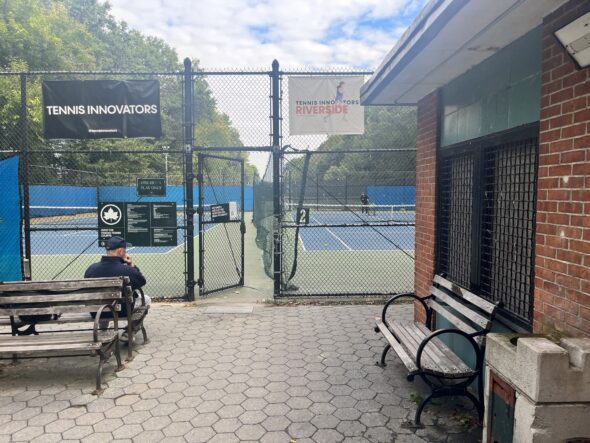
There’s a line of people wrapped around the Riverside Park tennis courts on any given Saturday afternoon. Often upwards of 20 players wait for hours, even if they have reservations.
Those in line play with permits from the New York City Department of Parks & Recreation, which issues annual access passes for $100, the same price that some private tennis clubs charge by the hour for a court.
While the city issues more than 25,000 permits annually, there are only 100 public courts in Manhattan, all but one located north of 93rd Street. With an in-person reservation policy for an hour’s worth of play, New Yorkers who live in Midtown or further down are often stuck in-line for hours, with no guarantee of getting a court at all. A growing number of permit holders who have to travel Uptown are frustrated with their options: either wait in line at public tennis courts, or hope that some of the private clubs in Midtown come down in price.
Clark Wang has an all access pass, but lives in Battery Park City. Between travel and wait-times, it can take him a few hours to secure a single-hour court reservation. The only other public court he can use is a single one in Tribeca.
“You have to get there by 7 a.m. to get a spot and it’s just infeasible,” Wang said. “I can’t hit in the middle of the day, when courts are probably pretty free.” Instead, he finds himself in line on weekends or in the evening when the courts are busiest.
Jerome Norris, a Bronx native and New York City public school teacher for over 20 years, has been playing tennis since growing up in the Riverdale section of the Bronx. Norris said he has played tennis at public courts in every borough but Staten Island, but mostly plays in Manhattan, where demand for courts has exploded since the pandemic.
Tennis was an “available source of recreation that wasn’t being monitored,” said Norris. “There was no attendant station there, everything was closed down.”
And Norris’s observation is consistent with national and city trends during the pandemic.
According to this year’s Tennis Industry Association Participation Report, the number of tennis players in the U.S. increased by 5.9 million, or 33%, from 2020 to 2022. In New York City, the Department of Parks & Recreation issued 4,000 more annual permits in 2021 than 2019, an 18.5% increase.
The U.S. Open has also contributed to tennis’s rising popularity in the city. The tournament’s “Fan Week,” launched in 2017, transformed a once overlooked week of qualifying matches into a series of events and giveaways that are free to the public. Tennis stars have also been known to visit public parks, said Norris, who recalled when former world number one ranked tennis player Caroline Wozniacki did a photoshoot at Riverside Park.
And trying to secure a court during the U.S. Open can be particularly challenging, said Norris. “People visiting and wanting to secure just a day pass or just a week pass to play on the courts, it puts a lot of stress on the city’s facilities.”
Eion Holder, who manages reservations at the Riverside Park tennis courts, said people stand in line for hours to play.
“This is common,” said Holder about a crowd in the waiting area. “It’s like this on the weekends.”
Private clubs, in contrast, have streamlined the reservation process. But joining these clubs to avoid wait times comes at a premium.
Norris said he used to work as a hitter in the early 1990s at Manhattan Plaza Racquet Club, located on West 43rd Street. While it boasts five newly resurfaced hard courts in an indoor facility, an annual membership costs $3,350 at minimum.
The Vanderbilt Tennis Club, inside the Grand Central Terminal, charges by the hour. While rates can drop to $85 for reservations between 12 a.m. to 2 a.m., typical rates exceed $350.
Sutton East Tennis Club, located under the Queensboro Bridge on East 60th Street, allows city permit holders to use its eight indoor clay courts during the summer. But during the other months of a year, the club charges a minimum of $100 an hour during the day.
Pranav Mudiam, a consultant in Hudson Yards, plays at Sutton East during the summer, but returns to the city’s public courts in the fall. “It’s like anyone without absurd wealth or a professional level of tennis dedication gets priced out of the sport,” he said.
In an emailed statement, Kelsey Jean-Baptiste, a Parks & Recreation press officer, said the department “acknowledges the increased wait times,” adding that “two tennis courts, both at 96th and 199th, have also been added to our online reservation system to alleviate long wait times.”
But making reservations online for tennis courts cost an additional $15 and only a subset of locations allow for advance reservations. In some cases, the earliest available court times can still take days to secure online.
Jean-Baptiste did not respond to questions about the city’s decision to concentrate public tennis courts north of 93rd Street.
While available tennis courts remain hard to find in Manhattan, Holder said he tells his friends to “come to Brooklyn,” where courts near his home are always empty. “Nobody uses them,” he said.